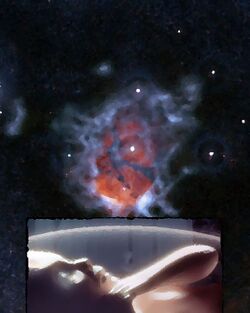UnNews:Telescope Views Infant in Outer Space
| The news outlet with approval higher than Congress | ✪ | UnNews | ✪ | Tuesday, December 2, 2025, 18:21:59 (UTC) |
| Telescope Views Infant in Outer Space | 
|
11 November 2008
A telescope image reveals how an bubble of ionised gas about is causing matter to collapse into dense clouds that form a massive infant. This region is about 8600 light years from Earth, towards the constellation of Capricorn. The infant in its centre is emitting huge amounts of ultraviolet radiation, which ionises the gas, taking away the electrons from hydrogen and producing the universe around us. Scientists believe that God may actually be a baby.
As this infant expands, the shock wave sweeps up cold gas and interstellar dust. This layer becomes unsustainable and crushes itself under its own gravity into clumps creating new stars. This infant is important in studying the early stages of the life of stars. The light of the clouds is a measure of their mass, this also means that astronomers can now study the formation of less massive stars than they could before thanks to this huge space infant.
Ever since this discovery, scientists have had to confront the possibility of religion and the fact this may be God. However, many scientists who are militant atheists believe that we should abort this huge interstellar infant. This being is about 200 light years closer every day, so God will be here to visit us in 43 days. This could mean another possible second coming.
At the moment, astrologists are observing for more infants in space. Nothing was found but useless discoveries like space debris, dead stars, spaceship wrecks, life on other planets, a parallel reality and a restaurant at the end of the universe. However, there is still mystery who created this infant. The only possible answer is that this infant does not exist. We as scientific people will deny this infant and if it comes we close our eyes and pretend it is not there even though it really isn't.
There is a huge baby in space?
European Southern Observatory
References[edit]
"Telescope Views Glowing Stellar Nurseries." ScienceDaily. 11 Nov. 2008. Sciencedaily.com. 11 Nov. 2008 <http://www.sciencedaily.com/releases/2008/11/081111074654.htm>.
